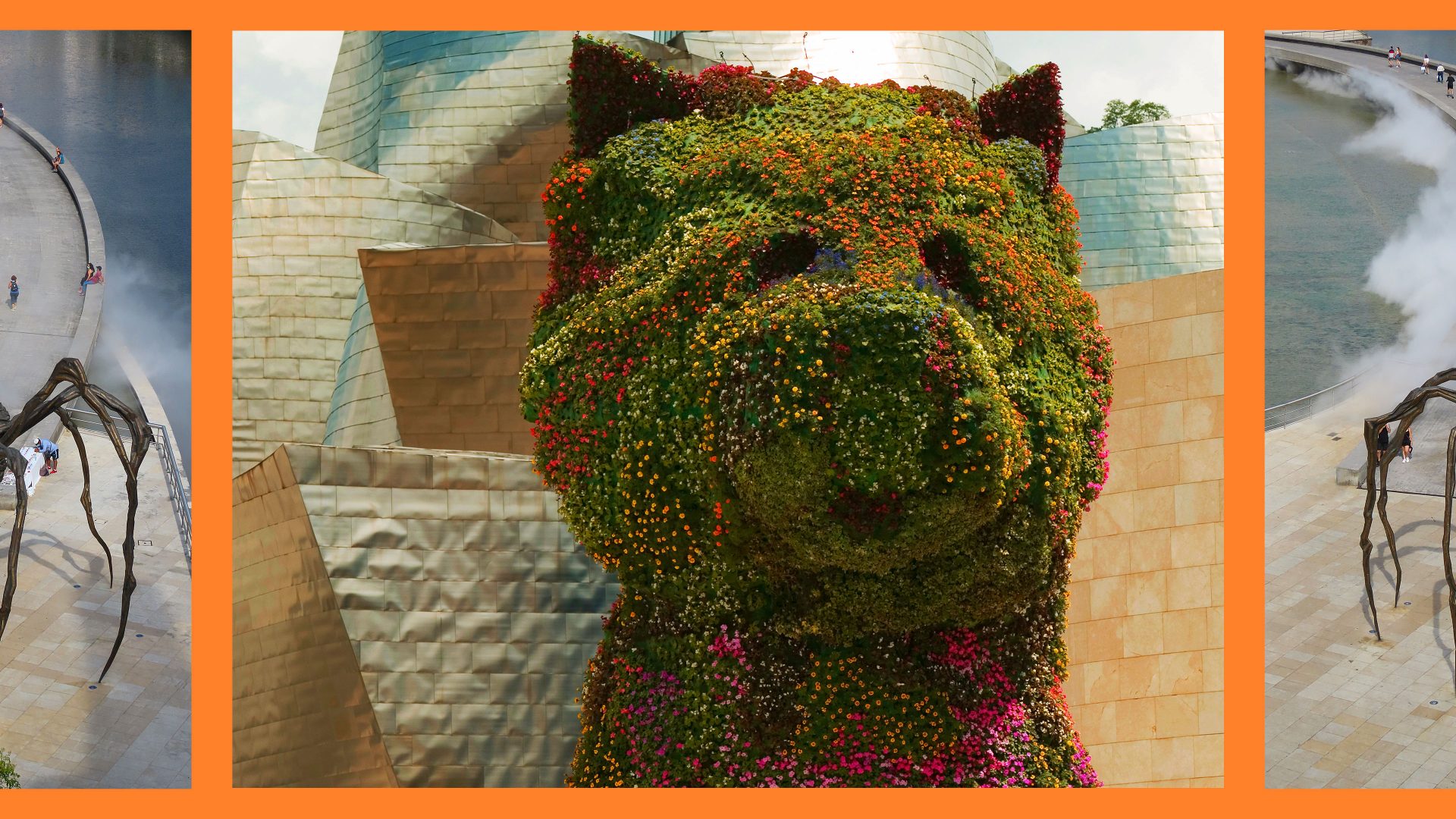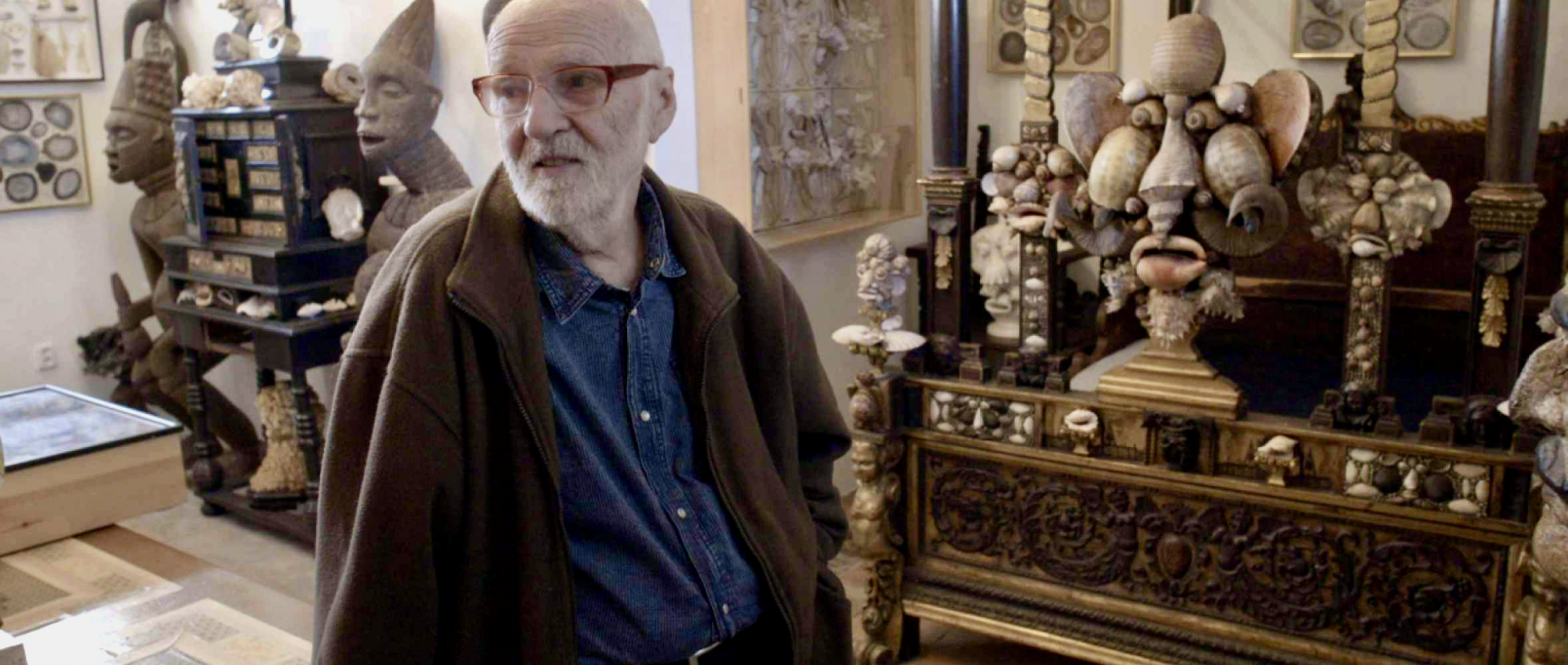A giant young terrier, coated in flowers rather than hair, is a doorkeeper at the Guggenheim Museum in Bilbao, the biggest city in the Basque Country. Jeff Koons’s Puppy – currently dressed for the winter in pansies, antirrhinums and white alyssum, has been greeting visitors since the art gallery opened 25 years ago. Superficially playful, Puppy belies its exacting upkeep: 60,000 seedlings are planted twice a year, following a geometrical grid laid down by the American artist, although seasonal colour choices can be made by a curator. So many plants are needed that they have to be cultivated to order, and the species are chosen according to the amount of sunlight on the animal: the chin is in permanent shade, the head gets full sun all day. Although Bilbao is used to high temperatures pretty much year round, Puppy’s new winter nose is blue.
A light touch combined with well-disguised attention to detail is consistent with the personality of the Guggenheim, the design masterpiece of Canadian-born American architect Frank Gehry. He regards it as his most
important work, confirming his special affection for the waterside art museum by celebrating his 85th birthday there, inviting 350 guests to a
piano recital by his friend Daniel Barenboim. For the 25th anniversary,
at 93, he popped back again from his New York studio.
With its flight of metallic wings that flutter above the River Nervión, this
landmark building is the most visible symbol of a regeneration project that
has been a clear commercial, social and aesthetic success. Even 25 years
later, it is breathtaking in its vision.
In the 1980s, Bilbao was on its knees. Many of its ills have resonances in today’s Britain. Shipbuilding, once a vital trade creating many jobs, had
collapsed. Other industry was in decline, derelict sites scarring a city once
prosperous enough to build with Belle Époque confidence and elegance. Lesser minds would have cut public spending as prosperity collapsed, but local authorities set out in a different direction, ploughing money into regeneration schemes – of which the Guggenheim is only one – reviewing city planning, pedestrianising, beautifying, raising hopes. Enlightened private partners were persuaded to invest too, notably, in the case of the Guggenheim, the Spanish bank BBK, still the museum’s best friend.
“The idea that culture could be a factor for development originally met
with scepticism and a degree of mistrust,” admits Juan Ignacio Vidarte, director general of the Guggenheim Museum Bilbao, in a publication to
mark the anniversary. “But the success of the Guggenheim Bilbao from its
first year onwards backed up this conviction… The history of our institution provides proof that the cultural factor was decisive in persuading businesses to set up here and as a stimulant for the growth of tourism and services, and, finally, a vector to help promote the region’s image abroad.”
The Guggenheim Effect became a paradigm for others, though few have pushed the boat out this far or hauled in such a catch, arguably because too
much was expected of a single venture. The Bilbao story demonstrates that
several projects must be taken in parallel. Today, double the expected number visit the museum, on average one million people a year. More than
60% come from abroad, led by France. Visitors stay the night, eat out, go shopping, tell their friends. The Guggenheim calculates that the museum has led to €6.5bn (£5.6bn) being spent in the Basque Country, yielding nearly €1bn in tax revenue. It makes work, directly or indirectly, creating jobs for more than 5,000 people.
Gehry’s design evokes the natural world, for all its surface metal, with curves rather than straight edges and a snail-like spiral interior from which run arteries. Galleries appear organically, rather than systematically, and the building is unashamedly an artwork in its own right, allowing curators to hang works in a way that interacts with their surroundings rather than those surroundings being an invisible backdrop.
Such a conversation is particularly audible in the installation of the huge, eight-piece work The Matter of Time by the American sculptor Richard Serra. Like Gehry, he describes his Bilbao installation as his most important
work. As it winds through a vaulted and cavernous space reminiscent of an
upturned boat, it speaks not only to Bilbao’s past, but also to the artist’s upbringing in San Francisco. There as a boy he watched the launch of ships
worked on by his father, Tony, a pipe-fitter, a memory he describes as providing him for life with the raw materials of his monumental art – metal and gravity.
As if to reward its visionary plans, good luck was visited upon the city of
Bilbao in the form of perfect timing. Its quest for regeneration coincided with the search by the Solomon R Guggenheim Foundation for a new outpost for its remarkable collection of modern and contemporary art. With galleries in New York and Venice, and after an abortive attempt to extend the
latter, it enthusiastically fell in with the Bilbao scheme. A proposal to use an old wine warehouse was abandoned in favour of disused dockland on a bend in the river.
Today both banks of the Nervión offer extensive footpaths, washed until spotless night and day and punctuated with sculpture, cycle paths and neatly
mown strips of grass. The Zubizuri bridge by the contemporary architect Santiago Calatrava swoops and dives between riverbanks like a great white bird, and walkers rounding the bends see the Guggenheim rise up like a finned sea creature.
The Guggenheim project also coincided with breakthroughs in software for architects that allowed apparently fantastical concepts to become reality. Created initially by the French firm Dassault for the design of fighter jets, CATIA was both adopted by Gehry’s studio and further developed there as a tool for the architectural team. With state-of-the-art CATIA, but also the aid of simple wooden blocks like a child’s playthings, the Guggenheim went from sketchbook to skyline. An early Gehry drawing of it looks as though someone has sketched a gaggle of geese while blindfolded. And yet it unmistakably depicts the building we know today.
Gehry originally planned to use leaded copper for the petals of this great unfurling flower, but its toxicity ruled it out. Stainless steel was also considered and rejected, and then the architect alighted on titanium. Sheets
only one-third of a millimetre thick and softly textured, it is light enough to move gently in the wind. “Bilbao was miraculously made of titanium,” the architect says.
For its opening in 1997, works of art were loaned by the Guggenheim Foundation, but in the intervening years a distinctive collection of around
180 works has been acquired, some, like Serra’s, on a colossal scale. The
anniversary show features, for the first time, 145 of these pieces. For the
exhibition Sections/Intersections: 25 Years of the Guggenheim Museum
Bilbao, each of the museum’s three floors are devoted to Bilbao’s own works, masterpieces of the 20th and 21st centuries. Collaborations with living artists among those exhibiting in the many temporary exhibitions have often resulted in a new acquisition for the collection.
Other technological advances have literally opened up the Guggenheim. A
combination of factors, including the nature of the works in the evolving
collection and improvements in lighting, notably LEDs, have allowed curators to strip out walls that were introduced to protect artworks from
natural light. Today that light streams in through vast windows, transforming the visitor experience and connecting the displays more visibly with the outside world.
Curators introducing the celebration events explained that there are artists
on the shopping list, and that it can take several years to nail the right piece for the collection. While the Guggenheim collections in New York and Venice have extensive holdings of early 20th-century work, Bilbao has carved out its speciality as work from the postwar period. The earliest work, which dates from 1952, is Mark Rothko’s three-metre Untitled, and there are strong pieces from artists who today are becoming unaffordable, so that investment in tomorrow’s big names is an imperative. Notable names represented include Georg Baselitz, Anselm Kiefer, Richard Long, Joseph Beuys, Cy Twombly, Robert Motherwell and Louise Bourgeois, whose giant spider Maman picks her way along the approach from the river.
But fashions in curating change, and there is a trend away from chronology
in favour of themes and interactions with visitors’ own experience. At the
Guggenheim, the history of modern art is recorded on the third floor of its
new exhibition. The natural world and built environment are at the heart of
the other two floors, silently asking questions about our relationship with the planet.
An impressive new acquisition, Rising Sea (2019) by the Ghanaian artist El Anatsui, is a metallic sheet that drops from ceiling to floor, colour bands suggesting the sky, the sea, and cityscapes. The “cloth” is made from bottle tops, flattened and sewn together with copper thread, and bottle foils, folded into slim rectangles to create waves – like pointillism in aluminium – and they threaten to engulf the towns. The recycling of the detritus from bottles
of drink also refers to the artist’s heritage and the one-time exchange of liquor for slaves.
That Bilbao flourished and then foundered on changing patterns of trade is a lesson for others who cling to the past and regard creativity as subversive or indulgent. Says Richard Armstrong, director of the museum and foundation: “In the last 50 years of cultural history, Guggenheim Bilbao is the most important demonstration of the power of art to revive a city.”
Sections/Intersections: 25 Years of the Guggenheim Museum Bilbao runs until January 22, 2023




